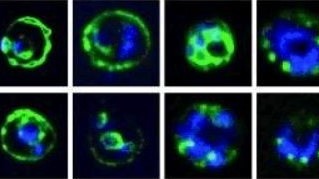Unit | Malaria Host Interactions
The Malaria Host Interactions Unit is studying the molecular interface between malaria parasites and their human host. Recent findings revealed the existence of intimate links between parasite metabolism, gene regulation and the host environment. It has become evident that intra-erythrocytic Plasmodium falciparum parasites are able to sense nutritional cues and adapt to changes in their vicinity by inducing specific transcriptional responses. This capability is surprising in light of the fact that malaria parasites have lost canonical nutrient sensing pathways present in other eukaryotic organisms.
We aim at identifying and characterising the molecular players and mechanisms that facilitate environmental sensing in P. falciparum. Further, it is the explicit ambition of our group to translate knowledge gained from basic research into applied approaches where needed.

Nicolas Brancucci
Tenure Track Assistant Professor, Swiss TPH Person of Trust, Dr.
Head of Unit
+41612848653
,
*
nicolas.brancucci@swisstph.ch
Selected Projects
Nutrient Sensing in Plasmodium falciparum
During their life cycle, malaria parasites enter different milieus in both the vertebrate host and the mosquito vector. Parasites have to adapt to these changing conditions and it is therefore not surprising that they have evolved strategies to link developmental decisions to signals in their environment. This also holds true for the intra-erythrocytic stages of the parasites: While the red blood cell provides parasites with essential nutrients and shields the intruder from host immune responses, the intra-erythrocytic localisation seemingly isolates P. falciparum from the outside world. Despite this spatial separation, parasites are able to sense external signals, including the host-derived serum lipid lysophosphatidylcholine (lysoPC). Intriguingly, parasites are able to induce specific transcriptional programmes in response to changing lysoPC concentrations. This allows parasites to control essential processes, including growth, metabolism, cell cycle exit and the production of transmission stages in an adaptive manner. The apparent lack of canonical nutrient-sensing pathways in Plasmodium species, however, raises questions about how parasites are able to perceive nutritional stimuli and how these environmental signals are translated into appropriate downstream responses.
It is the aim of this project to identify and functionally characterise the molecular players involved in environmental sensing of malaria parasites. We are combining our expertise in P. falciparum cell culture with diverse reverse genetics approaches and phenotypic readouts to reach this aim. Read more
Identification of Malaria Transmission-Blocking Compounds
Malaria transmission is mediated by sexual stage parasites, the so-called gametocytes. At maturity, these gametocytes have the unique capacity to establish an infection in the Anopheles mosquito vector. Gametocyte formation and maturation, hence, are essential steps for the successful spread of parasites within the human population. Because gametocytes are formed at a generally low rate during each round of intra-erythrocytic parasite multiplication, they are low in abundance and represent a potentially vulnerable bottleneck in the Plasmodium life cycle.
Transmission interventions are considered key components of ongoing malaria elimination campaigns. Yet they are hindered by the generally low activity of antimalarial compounds against gametocytes. Based on recent insights into gametocyte biology, we have developed a high-throughput drug screening assay currently used to identify gametocytocidal compounds. We expect to identify parasite components that may be used as drug targets in future transmission-blocking interventions.
Development of Enzyme-Based Malaria Diagnostics
There are still more than 220 million malaria cases each year, of which 400`000 have fatal consequences. In the light of these figures, it is needless to say that this devastating disease has a huge impact on global health. Noteworthy, a large proportion of people does not get access to diagnostic tests. Ideally, malaria diagnostics have to be highly sensitive, specific, reliable, easy to use and – very importantly – cost effective. As current methods fall short on combining these characteristics, there is an evident need for the development of new diagnostics approaches.
We are currently examining whether it is possible to exploit Plasmodium-specific enzymatic activities for the detection of malaria parasites by combining enzyme biomarkers with novel substrate-based detection methods.
Latest Publications
All PublicationsDarif N.D et al. BioMalPar XX: looking back on, and forward from, 20 years of malaria research. Trends Parasitol. 2024;40(8):651-656. DOI: 10.1016/j.pt.2024.06.012
Day C.J et al. The essential malaria protein PfCyRPA targets glycans to invade erythrocytes. Cell Rep. 2024;43(4):114012. DOI: 10.1016/j.celrep.2024.114012
Hellingman A et al. Next generation chemiluminescent probes for antimalarial drug discovery. ACS Infect Dis. 2024;10(4):1286−1297. DOI: 10.1021/acsinfecdis.3c00707
Thommen B.T. Investigating the link between nutrient sensing and gametocyte formation in the malaria parasite Plasmodium falciparum.. Basel: Univ. Basel, 2024. Doctoral Thesis, University of Basel, Faculty of Science DOI: 10.5451/unibas-ep96254
Voss T.S, Brancucci N.M. Regulation of sexual commitment in malaria parasites: a complex affair. Curr Opin Microbiol. 2024;79:102469. DOI: 10.1016/j.mib.2024.102469
Wyss M, Thommen B.T, Kofler J, Carrington E, Brancucci N.M.B, Voss T.S. The three Plasmodium falciparum Aurora-related kinases display distinct temporal and spatial associations with mitotic structures in asexual blood stage parasites and gametocytes. mSphere. 2024;9(9):e0046524. DOI: 10.1128/msphere.00465-24

 Aleksa Bojanic
Aleksa Bojanic
 Nicolas Brancucci
Nicolas Brancucci
 Serej Ley
Serej Ley
 Leonie Seefeldt
Leonie Seefeldt